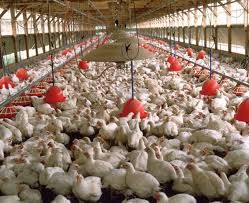
The LA Times Editorial Board has taken a strong stand on the excess use of antibiotics in animal feed and on farms, after the original reporting they did last week I covered in Pharmaceutical companies agree to "reduce" use of antibiotics for animals "on labels" - sort of. Portions of this previous post are replicated portions of this below the orange squiggle for your convenience.
In The LA Times editorial board notes many consumer are not aware of the extent to which some of our last-line-of-defense antibiotics are being added to livestock feed, and we are not aware the dangers this is creating the evolution of antibiotic resistant "superbugs" - microorganisms resistant to our current arsenal of antibiotics. Even though it is a virus, not as bacteria, the Ebola epidemic of Africa is a reminder of what infections could be like before the days of readily available and effective antibiotics to fight them.
Last week, the FDA proposed new guidelines to reduce the overuse of antibiotics in animal feed used for livestock on American farms which will cut into the profits of pharmaceutical companies. The proposals was going to require a change in labeling until somehow in the last week, it was changed to be a voluntary guideline, angering many scientists, which you can read about in my post last week.
The lavish use of antibiotics among livestock operations — 80% of all antibiotics in the country are fed to food animals — has contributed to the rise of resistant infections that are difficult, expensive and sometimes impossible to treat. A September report by the Centers for Disease Control and Prevention revealed that resistant infections sicken 2 million Americans each year, killing 23,000 of them and adding $23 billion annually to the nation's healthcare costs.
Many consumers aren't aware that antibiotics are routinely added to feed to make cattle, pigs and other animals grow faster and to prevent disease from sweeping through crowded, unsanitary pens. The guidelines call for banning the use of medically important antibiotics as growth promoters and ending all over-the-counter sales; a veterinary prescription will be required. Animal farms could use these medications to prevent illness only in cases in which a veterinarian determines that the animals are at high risk of infection — for example, if a few animals have already fallen ill — and even then, use of the drugs is supposed to be limited to treating the animals at risk, not all the animals in a facility.
The new guidelines are voluntary. We would rather they were law, but there is ample reason to think they will be widely followed. The two pharmaceutical companies that between them manufacture most of the affected veterinary antibiotics have signed on to the plan and have said they will change their labeling to reflect the guidelines. Existing laws barring off-label use of veterinary drugs would then make it virtually illegal to use them for growth. Trade groups for pork, chicken and beef producers also have come out in support. The agency has made it clear that if antibiotic use doesn't drop, it will develop rules with teeth.
The post I wrote on this last week has a poll asking if you agreed or disagreed with the FDA's decision to make the guidelines "voluntary" in order to avoid a legal battle with industry. Only 16 people responded. If I have time I'll replicate the poll here, but I need to make final arrangements with our moving company to Florida before 5:00 p.m. Please check back latter.
Pharmaceutical companies agree to "reduce" use of antibiotics for animals "on labels" - sort of

I woke up early, today, to go to my doctor, for my first month's weigh in my new super diet. I have lost 6 pounds, which should be enough to keep me out of the "circle of shame." So, I was extra happy to read Dan Pierson's More drug makers agree to limit antibiotics for farm animals, in the LA Times. Here, finally, seemed to be an upbeat success story about the FDA and 25 out of 26 big agribusinesses voluntarily cooperating to do the right thing for the common good of the people, by reducing the excess use of antibiotics to promote growth in healthy farm animals.
The Food and Drug Administration said 25 of 26 drug companies that were asked to phase out antibiotics to promote growth in farm animals have agreed to comply with the agency’s voluntary plan.
80% of all antibiotics are used on farms, often on health animals to promote growth and control unsanitary conditions which is leading to anti-biotic resistance. We learn from Pierson that the CDC reports 2 million people are afflicted with "superbugs" that contribute to 23,000 deaths/year.
So far so good. I looked forward to finally have some good news to report after my image consultants warned me of becoming typecast as the "alarmist" always bearing bad news. "you don't want to be in the next crowd of leftists to get kicked out. You leftest are always getting kicked out, Oy," they said. "you better shape up and start being pleasant. And smile more, and say nice things about people!" As if my life were not tough enough already with this diet.
Well, okay, this shouldn't be that hard, here's a good article to start the new "Happy HoundDog campaign with.
"But, then the news was rather sad, but I just at to laugh."
Turns out chickens are excepted. Then the real truth comes out. When the FDA proposal first came out in December, they asked drug makers to remove the "growth promotion claims from their label, making it illegal to prescribe antibiotics for anything other than medical reasons. But fearing manufacturers would resist the plan, causing costly litigation and delay, they made the plan "voluntary."

We do not learn what is really going on until an interview with the Avinash Kar, of the Natural Resources Defense Council, who notes that the same animals can be given exactly the same antibiotic for crowded and unsanitary conditions, so all that that happened is a minor labeling change to divert the long drive by the scientist in, and out of the, the FDA, and doctors who have dedicated their lives' to fighting the development of antibiotic resistant superbugs. The leadership of the FDA seems to have "caved," responsibility for which ultimately rests on "our" doorstep. Perhaps, this explains why "leftist hounddogs often look so sad with our droopy jowels.?
Rogers said the FDA also needs to crack down on antibiotic use to compensate for overcrowded and unsanitary conditions on farms.
While no statistics exist, Avinash Kar, an attorney for the Natural Resources Defense Council, fears that antibiotics could still be used widely for this reason.
“The FDA is just limiting antibiotic use for growth promotion, but the same animals are given the same antibiotics because of the crowded conditions,” Kar said. “Current levels of antibiotic use are likely to continue, but just with a different justification and label. That won’t do anything to protect human health.”
So much for my "Happy HoundDog Campaign." Perhaps, this is a step in the right direction and our Obama administration is secretly fighting a tough battle behind the scenes, and offering encouragement to the many scientists and activists who've been dedicating their lives to fighting the terrifying emergence of antibiotic resistant superbugs, who must now be discouraged and feel betrayed.
I'll have to do more research into this. Fo now I'm back to my using cynical self. Oh well, that will change soon, as there's a Burger King right next to the doctor's office, and I haven't eaten or drunk anything for the last 14 hours. In 2 hours it's going to be HoundDog go wild time in Boston! And to make sure we have a tie in for his article I'm going to break my six month long fast of red meat and have me some antibiotic resistant hamburger. Woof, woof! Then we will see what true happiness looks like.


